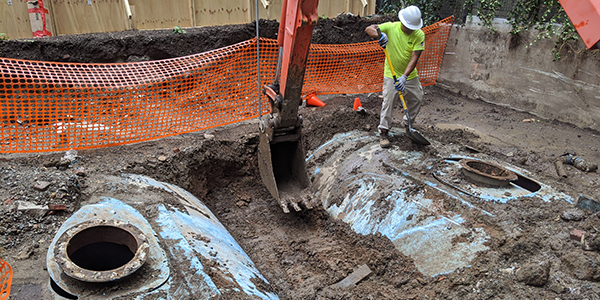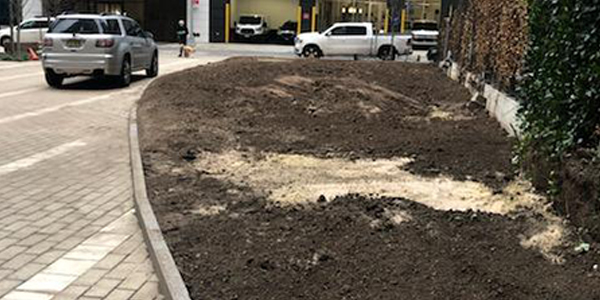Project Summary
In June 2020, ESA was retained by a property management consultant to remove two 15,000-gallon No. 2 fuel oil Underground Storage Tanks (USTs) that serviced a high-rise residential apartment building on West 43rd Street in Midtown Manhattan. The USTs, which serviced the building’s boiler unit since the early 1980s, were located in a landscaped area situated between a parking/courtyard area and a neighboring building and bordered by the 43rd Street sidewalk. The size of the existing USTs and their proximity to nearby structures and 43rd Street significantly complicated the removal. Additionally, during initial UST cleaning activities, free product fuel oil was identified in soil between the tanks, requiring regulatory spill hotline notification and immediate mitigation. ESA implemented a comprehensive UST removal and remedial strategy that addressed the soil contamination and protected the surrounding structures while complying with New York State Department of Environmental Conservation (NYSDEC) and New York City Department of Environmental Protection (NYCDEP) technical guidance and regulations. Following removal and remediation of the leaking tanks, a new UST was installed as an emergency back-up service to the building’s natural gas-fired boiler unit. The execution of these field activities led to the timely closure of the associated NYSDEC spill number and facilitated the acquisition of UST insurance for the property owner.
Challenges
Based on the above logistical challenges and the need for rapid completion, the tank removals and soil remediation were conducted in a manner that protected the integrity of the surrounding structural features while allowing for 24-hour public access to the apartment building complex and parking garage and satisfying NYSDEC technical requirements for closure of the spill case number. This complex remedial workplan required the coordination of multiple entities. These included the property owner, property management consultant, insurance company representatives, UST removal and installation contractors, a structural engineering design firm, drilling and shoring installation contractors, New York City Department of Buildings (NYCDOB), and State and municipal environmental regulators.
ESA’s Solution
ESA facilitated the design and implementation of a professionally engineered shoring system permitted by the City that included installation of steel soldier piles, walers, and wooden lagging to facilitate soil excavation around the USTs. This allowed the USTs to be cut and removed in sections, thereby preserving the integrity of the surrounding structural features. Each tank was cleaned, sawcut/torch cut in approximate 10-foot sections and removed while fuel oil-impacted soil was excavated. Then timber lagging was installed to provide side-wall support, preventing soil cave-in and/or excavation collapse. Due to the proximity of the adjacent building and depth of the building’s footer, an entire sidewall of the UST shell was abandoned in place per the permitted engineered shoring designed. Removal of impacted soil was completed vertically and horizontally to the extent feasible, free product mitigated via vacuum extraction, and post-excavation soil samples were collected throughout the excavation to demonstrate remedial effectiveness.
Outcome
Given the site’s complexity and the physical constraints of the property, the UST removals and soil remediation/free product mitigation activities were completed efficiently and quickly, below the estimated budget, and with minimal disturbance. Post-excavation soil sampling confirmed that sufficient impacted soil was removed to comply with NYSDEC cleanup regulations. The evaluation of an observation well located in the 43rd Street sidewalk adjacent to the USTs demonstrated that free product migration to groundwater did not occur; therefore, further groundwater investigation and remediation was not warranted. Having confirmed soil and groundwater compliance, ESA prepared a comprehensive UST removal and remedial action summary report to facilitate spill case number closure through the NYSDEC Petroleum Bulk Storage (PBS) program. Thanks to ESA’s comprehensive removal and remediation strategy, efficient project management, and technical execution, NYSDEC reviewed ESA’s summary report and closed the case. This allowed for immediate installation of a 12,000-gallon replacement/emergency power backup fuel oil UST and enabled the property owner to obtain an insurance policy for the new UST system. The entire project execution and regulatory spill case closure was completed in under six months.






